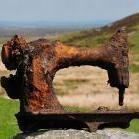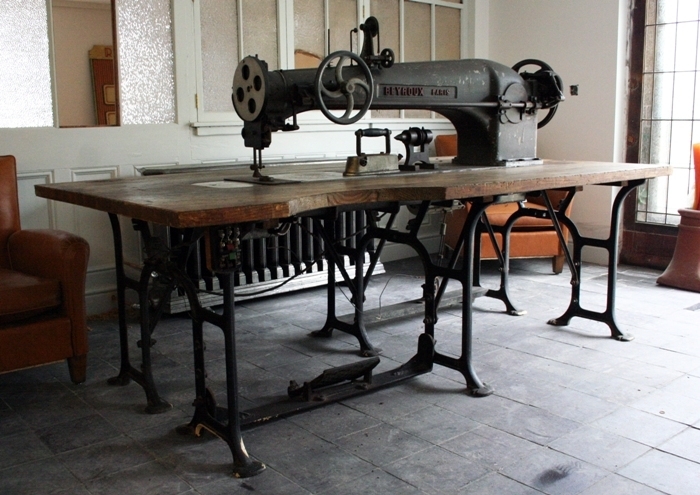-
Posts
193 -
Joined
Content Type
Profiles
Forums
Events
Blogs
Gallery
Everything posted by trash treasure
-

Long shot...Siruba machines?
trash treasure replied to Sugarkryptonite's topic in Leather Sewing Machines
OK - Yes that's the inner point - The little point closest to the needles, that actually catches the thread - That's the one you measure from. Yes, you have to use both screws to adjust it - On the Kansai, the bottom of the spreader needs to be 9-11mm above the needle plate, to start with. Loosen both screws to get it in the orientation I described above - The spreader should NOT contact anything but thread, anywhere in it's travel. I didn't see that you said your manual had no info on it - I told you I need magnifying glasses ;~) Now, your real assignment is to go find yourself a proper service manual for that thing, really - If you have to pay for it, it'll still be well worth it. -
Buy the Consew - The Consew is a compound feed walking foot machine, and the sailrite has what's called a "jump foot" - Very different machines. The low re-sale value on the Sailrite should tell you something ...........
-

Long shot...Siruba machines?
trash treasure replied to Sugarkryptonite's topic in Leather Sewing Machines
I just looked at your photos again, and it looks like you HAVE a manual - Doesn't it have the spreader adjustment in there? Why did I just type all that? -

Long shot...Siruba machines?
trash treasure replied to Sugarkryptonite's topic in Leather Sewing Machines
Bob is right - That arm is called the spreader, and it mounts where your circle is, and travels back and forth to "spread" the upper thread across the stitch. You do know, that on these machines, the handwheel rotation is CLOCKWISE - REVERSE, like a serger, right ? Now keep in mind, I have a Kansai, but it's a similar machine, making a similar stitch - On the Kansai, the spreader is adjusted so the right, inner point clears the LEFT needle by about 0.5 - 0.8mm, as it travels past from right to left on the needle downstroke. At the end of it's leftward travel, the same inner point should wind up 4.5 - 5.5mm to the left of the left needle, just before it reverses travel. I keep editing this, as I remember stuff - You have to make sure the spreader clears the thread guides - For the guide with the curved hole - At it's RIGHT travel end, the point should be approx. centered under the curved slot - So adjust the guide accordingly. For the upper, small moving guide, at the end of it's downstroke, make sure it clears the lower guide by about 1mm and is centered, or a little bit to the left of the center of the slot on the lower one. WHEW ! I've done these adjustments, and it's really not hard to do, if you have good eyes (or magnifying glasses, like I do), and some metric Allen wrenches (I see yours are just regular screws), so if you can't find more specifics for your Siruba, this will probably get you in the ballpark, hopefully. But I'd really urge you to try and get an adjuster's manual for that series, if at all possible - It'll save you a lot of grief :~) The actual TIMING of the spreader is done internally, and is supposed to be adjusted depending on the thread used. But I don't have a Siruba, and I'll not pretend to tell you about adjusting that! These machines, being self-oilers, are unfortunately going to be oily, especially as they are used and a little worn - There MAY be an adjustment for the oil feed, but I don't know on your machine - You'll just have to keep ahead of the lint, by blowing it out with compressed air - It could get messy! Just use "Lilly White" type sewing machine oil - Buy a gallon! Good Luck! -
This is actually pretty interesting - If the modification results in that much less tension needed, then there might be a real benefit with pucker reduction for seaming some fabrics - I may have to do some experiments on my own ...........
-

Long shot...Siruba machines?
trash treasure replied to Sugarkryptonite's topic in Leather Sewing Machines
I believe you're correct - That machine will do a 5 thread safety stitch or a 3 thread (by pulling one needle), but it wont do a 4 thread stitch. -

Long shot...Siruba machines?
trash treasure replied to Sugarkryptonite's topic in Leather Sewing Machines
A trimmer is an option on these machines - really for production use, when you have miles of seams to sew. We use a Kansai WX-8000, without a trimmer, in our pattern and prototype shop, for knit work. My wife loves it - She says you'd have to pry it from her cold dead hands :~) I will say that, if you buy one, be aware that they are shockingly HEAVY - At least the Kansai is. We have it in a submerged table, and I had to reinforce the sub table (that the actually machine sits on / in), with steel angle, as it was starting to crack. So check the table .......... -

Long shot...Siruba machines?
trash treasure replied to Sugarkryptonite's topic in Leather Sewing Machines
Siruba is a major maker of these machines - Some of them are for specialized operations, though, so beware. That looks like an older top & bottom machine, and parts, etc may or not be available - Best advice is to go and sew it off with some fabric you want to use, and see if it does what you want. We have a Kansai coverstitch machine, newer than that one, and paid a LOT more for it - But if you sew knits a lot, they can do a miraculous job, if they're working right - If you buy it, find a service and parts manual if you can - They are complex machines, with a lot going on, mechanically - Think serger on steroids, and NOT for the mechanical faint-of-heart ........ -

Claes 8346 restoration questions
trash treasure replied to johnnyblaze's topic in Leather Sewing Machines
You might find a suitable spring at McMaster Carr - I've used their conical springs for sewing machines, before - Just pick one by size : https://www.mcmaster.com/compression-springs -
I like that ! I have an old Pfaff 130, with a horizontal spool holder, and it always seemed more logical to have the thread unwind that way, without twisting. I may just have to engineer something like that for the shop machines
-

Measuring new v belt length woes
trash treasure replied to Sugarkryptonite's topic in Leather Sewing Machines
I use a tailor's cloth tape measure, and measure around the outside of the pulleys - Usually get it pretty close. If you buy from a place like McMaster Carr, they list belts by the outer circumference, so that measuring method works well : https://www.mcmaster.com/drive-belts Also, there are on-line belt calculators : http://www.calculatoredge.com/mech/vbelt length.htm -
If you ever do get the belt to grab better (by shortening it, treating it, etc), one thing you should do, is that when you're not using the machine, slip the belt off the pulley, and leave it slack - It won't get so stretched out that way - This is a good practice with any leather belt treadle machine.
-
That pedal looks like an industrial type on-off foot switch - NOT a variable speed foot control. So, you're setting the speed with the DC controller, and then just turning the machine on and off with the foot switch - It runs then, at a constant speed ?
-

What adler is this 30-1, 30-5, 30-7?
trash treasure replied to Gunengraver's topic in Leather Sewing Machines
Whichever model that is, and whatever price he's asking, I think you should talk the seller down a bit - That motor is just too small ............ -

Help with info on unknown machine
trash treasure replied to fredk's topic in Leather Sewing Machines
Wiz is right - You'll get more specific info on a machine like this, in a forum dedicated to them : https://groups.yahoo.com/neo/groups/vintagejapansewingmachines/info?guccounter=1 -

Replacing "Hook" on my 211G156
trash treasure replied to Skylark53's topic in Leather Sewing Machines
I have a little magnetized screwdriver that I use for this - Also, a REALLY strong pair of reading glasses, so I can see them -

New industrial sewing machine table, where to buy?
trash treasure replied to myjtp's topic in Leather Sewing Machines
I personally think the old "H" leg stands are the strongest / most rigid, but they're going to be hard to find new - Probably could get one used from a place that buys up factory stuff -
Thank you for the clarification, jimi ! And also for the cool photo - I'll add it to my "archives"
-
As long as we're on the subject of monster sewing machines, I thought to post this one - I found this photo a while ago, and have no idea what the machine is/was for, except that it's BIG, and it's obviously just an "art object", now ....
-
Set up for double needle, even ! I think you DO really need it - Just think how it would look all polished and painted - You could spend endless hours, just staring at it
-

Found a Puritan on Craigslist
trash treasure replied to Londonfog's topic in Leather Sewing Machines
Looks heavy ............ -

Timing got off with reducer pulley!
trash treasure replied to rockthecasbah121's topic in Leather Sewing Machines
Does this machine have a safety clutch ? Or maybe the needle bar got pushed up - It looks like the needle's a bit high, as the hook passes.



